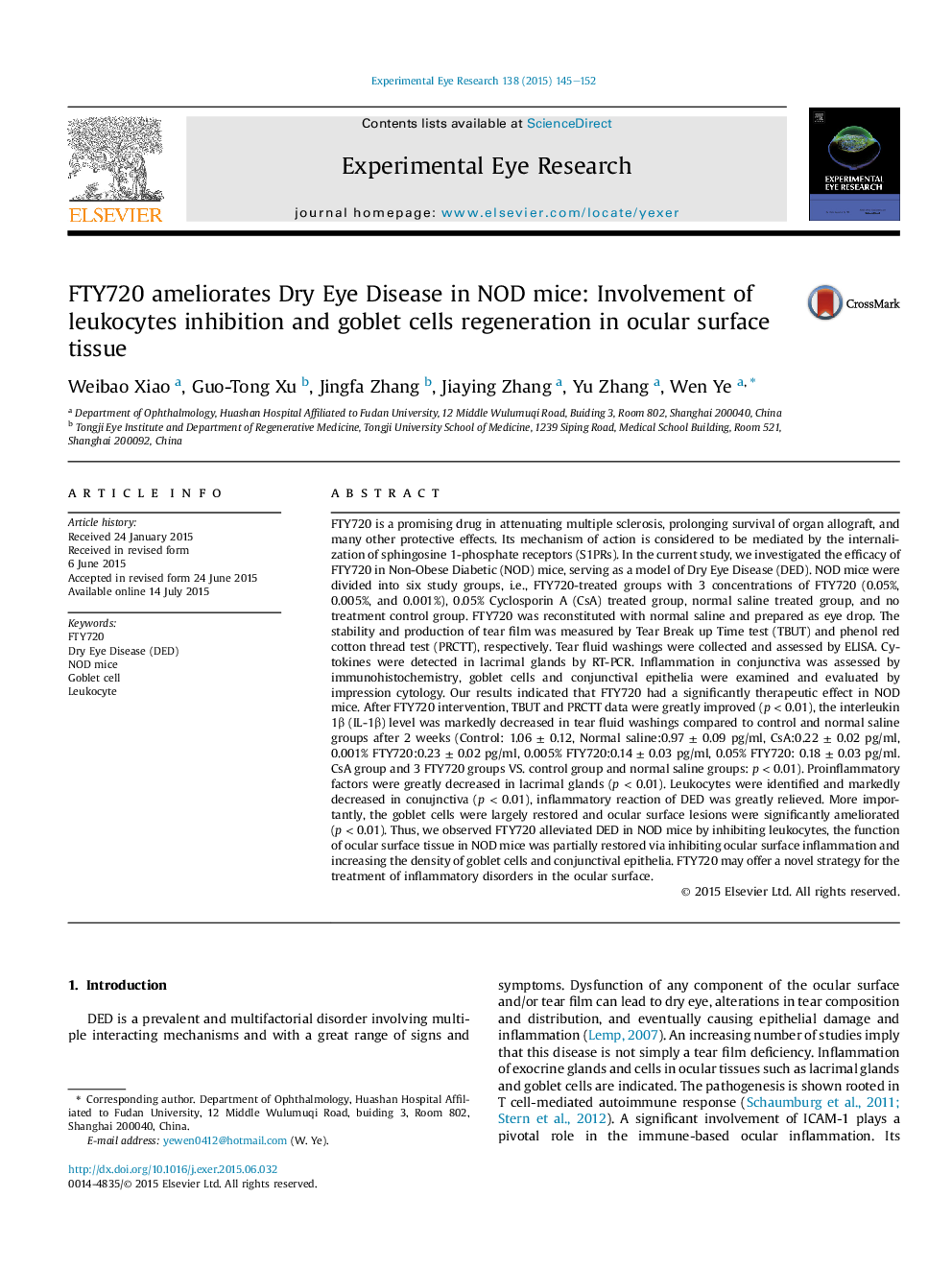| کد مقاله | کد نشریه | سال انتشار | مقاله انگلیسی | نسخه تمام متن |
|---|---|---|---|---|
| 6196577 | 1602584 | 2015 | 8 صفحه PDF | دانلود رایگان |

- FTY720 was the first time to be studied as an eye drop in a Dry Eye Disease (DED) mouse model (NOD mouse).
- Our results indicated that FTY720 had a significantly therapeutic effect in NOD mouse, the function of ocular surface tissue in NOD mouse was partially restored.
- FTY720 may offer a novel strategy for the treatment of inflammatory disorders in the ocular surface.
FTY720 is a promising drug in attenuating multiple sclerosis, prolonging survival of organ allograft, and many other protective effects. Its mechanism of action is considered to be mediated by the internalization of sphingosine 1-phosphate receptors (S1PRs). In the current study, we investigated the efficacy of FTY720 in Non-Obese Diabetic (NOD) mice, serving as a model of Dry Eye Disease (DED). NOD mice were divided into six study groups, i.e., FTY720-treated groups with 3 concentrations of FTY720 (0.05%, 0.005%, and 0.001%), 0.05% Cyclosporin A (CsA) treated group, normal saline treated group, and no treatment control group. FTY720 was reconstituted with normal saline and prepared as eye drop. The stability and production of tear film was measured by Tear Break up Time test (TBUT) and phenol red cotton thread test (PRCTT), respectively. Tear fluid washings were collected and assessed by ELISA. Cytokines were detected in lacrimal glands by RT-PCR. Inflammation in conjunctiva was assessed by immunohistochemistry, goblet cells and conjunctival epithelia were examined and evaluated by impression cytology. Our results indicated that FTY720 had a significantly therapeutic effect in NOD mice. After FTY720 intervention, TBUT and PRCTT data were greatly improved (p < 0.01), the interleukin 1β (IL-1β) level was markedly decreased in tear fluid washings compared to control and normal saline groups after 2 weeks (Control: 1.06 ± 0.12, Normal saline:0.97 ± 0.09 pg/ml, CsA:0.22 ± 0.02 pg/ml, 0.001% FTY720:0.23 ± 0.02 pg/ml, 0.005% FTY720:0.14 ± 0.03 pg/ml, 0.05% FTY720: 0.18 ± 0.03 pg/ml. CsA group and 3 FTY720 groups VS. control group and normal saline groups: p < 0.01). Proinflammatory factors were greatly decreased in lacrimal glands (p < 0.01). Leukocytes were identified and markedly decreased in conujnctiva (p < 0.01), inflammatory reaction of DED was greatly relieved. More importantly, the goblet cells were largely restored and ocular surface lesions were significantly ameliorated (p < 0.01). Thus, we observed FTY720 alleviated DED in NOD mice by inhibiting leukocytes, the function of ocular surface tissue in NOD mice was partially restored via inhibiting ocular surface inflammation and increasing the density of goblet cells and conjunctival epithelia. FTY720 may offer a novel strategy for the treatment of inflammatory disorders in the ocular surface.
Journal: Experimental Eye Research - Volume 138, September 2015, Pages 145-152